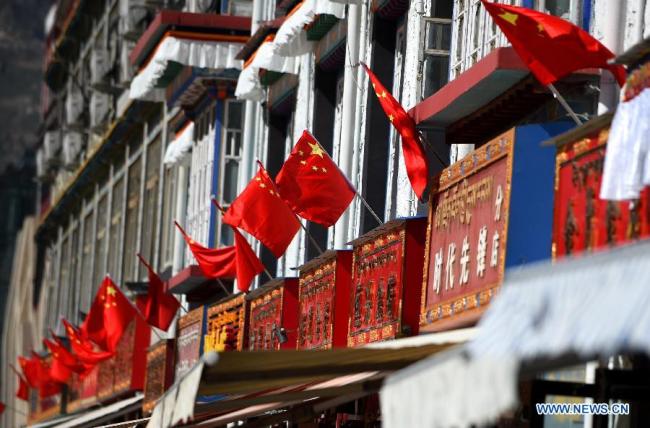 BEIJING, Sept. 6 (Xinhua) — China on Sunday issued a white paper on Tibet ahead of the 50th anniversary of the foundation of the ethnic autonomous region.
BEIJING, Sept. 6 (Xinhua) — China on Sunday issued a white paper on Tibet ahead of the 50th anniversary of the foundation of the ethnic autonomous region.
Titled “Successful Practice of Regional Ethnic Autonomy in Tibet,” the white paper said since the democratic reform was carried out in 1959 and regional ethnic autonomy came into practice in 1965, Tibet has established the new socialist system and achieved historic leaps and bounds in its economic and social development.
Tibet has taken a road that unites it with all China’s ethnic groups and struggles to develop equally, achieve prosperity, and make progress with them, it added.
As part of the Chinese nation, the Tibetan people fulfill the right to participate equally in the management of state affairs; they are thus managers of local social affairs and masters of their own destiny, creating and sharing the material and spiritual wealth of Tibet. “Tibet is now in its golden age,” the paper said.
Old Tibet was dark and backward as even in the 1950s, it was still a society ruled by feudal serfdom under theocracy.
Having existed for several centuries, this wretched system stifled human rights and destroyed human qualities, the white paper titled “Successful Practice of Regional Ethnic Autonomy in Tibet” said.
It was thus the most backward mode of human society under which the people had no democratic, economic, social, or cultural rights, and their basic human rights were not protected. Old Tibet was a far cry from modern civilization, according to the paper.
In old Tibet, the three major estate-holders and their agents accounted for only five percent of Tibet’ s population, but they owned almost all of Tibet’s farmland, pastures, forests, mountains, rivers, and beaches, as well as most of the livestock.
Serfs suffered three kinds of exploitations, including land rent, corvee labor – a broad term covering not only corvee, but taxes and levies, and rents for land and livestock, and usury.
Feudal serfdom under theocracy seriously obstructed social progress in Tibet. At the time of the peaceful liberation in 1951, there was almost no trace of modern industry, commerce, science and technology, education, culture, or health care, the paper said.
The implementation of regional ethnic autonomy provides an institutional guarantee for the people of all ethnic groups in Tibet to be masters of the country and of society in the real sense.
In Tibet, the people of all ethnic groups directly elect deputies to the people’s congresses at the county (district), township and town levels in accordance with the law; these deputies elect the deputies to the National People’s Congress (NPC) and the people’s congress of the autonomous region, the white paper titled “Successful Practice of Regional Ethnic Autonomy in Tibet” said.
From 2012 to January 2013, 94 percent of the constituency of Tibet Autonomous Region participated in direct elections at the county and township levels, among the four levels of the people’s congresses, it said.
Currently, Tibet has 34,264 deputies to the people’s congresses at all levels. Among them, deputies from the Tibetan and other minority ethnic groups account for 66.7 percent and 70.2 percent respectively of all deputies from Tibet to the NPC and to the People’s Congress of Tibet Autonomous Region, the white paper added.
In addition, in the 10th Standing Committee of the People’s Congress of Tibet Autonomous Region, 24 of the 45 members and eight of the 14 chairperson/vice-chairpersons are from the Tibetan and other minority ethnic groups.
By July 2015, the People’s Congress of Tibet Autonomous Region and its Standing Committee had enacted and ratified 123 local regulations that are currently effective, made 148 resolutions and decisions that have the same legal standing as regulations, and 29 regulations, resolutions and decisions it ratified have been repealed.
They total 300 in all, covering the building of political power, economic development, social stability, culture, education, language, protection of cultural relics, and environmental protection, according to the paper.

